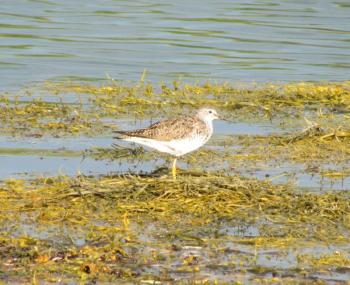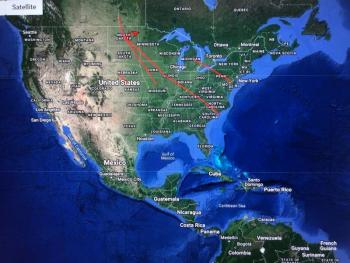More Yellowlegs Mysteries Revealed
You may remember that we wrote about the heroic journeys of lesser yellowlegs back in May. We described how Audubon Americas and partner nonprofit Selva started a project to place radio tags on 10 lesser yellowlegs in April on their wintering grounds in Colombia. Several of the birds made incredible apparently nonstop flights from there to the U.S. based on when they were detected at the MOTUS tower receiving stations that make up the network that tracks this type of tag.
After the birds moved through the U.S. in May, though, the signals disappeared.
Why?
Because these birds breed across the remote reaches of the Boreal Forest of Canada and Alaska where there are very, very few MOTUS towers but lots of the sphagnum-filled bogs that are their favorite nesting habitat. We have one of the EZ-Pass units on our car that registers when we drive past certain points on the turnpike and charges us a small fee for the segments we drive. When we leave the turnpike and drive on other roads, the signal from our EZ-Pass won’t be picked up. From the turnpike monitoring system’s perspective, we disappear when we are away from the receivers that pick up the signal.
In essence, that is what happens when those tagged yellowlegs go beyond the network of MOTUS tower receivers south of the vast Boreal Forest.
But some lesser yellowlegs begin their southward journey in July. In fact, a MOTUS tower in Michigan detected the first southbound individual of the 10 birds tagged in Colombia on June 23! Four more were detected from July 12 onward.
Rather surprisingly, three of the birds passed over the same MOTUS tower in central North Dakota—one on July 12, one on July 17, and one on July 20. That seems like a pretty remarkably consistent bird highway when you consider that three out of ten tagged lesser yellowlegs flew over that same spot over an eight-day period!
The individual first detected in Michigan in late June is now hanging out in wetlands just south of Philadelphia. Can you imagine going from the remote and very quiet Boreal Forest to the busy and noisy landscape of that region?
One of the birds that passed through North Dakota on July 20 made it to coastal North Carolina by the next day—a distance of about 1,500 miles! Three of the birds were last detected in the central part of the country.
We will be excited to watch for the hoped-for detection of the remaining five tagged yellowlegs if and when they come south from the Boreal Forest. And we have so many questions. Will more of them go through North Dakota? Will all of them fly to the Atlantic Coast or will some go down to the Gulf Coast? Will they stay very long in the U.S. or will they quickly move farther south? Will they migrate through the Caribbean islands or will they pass along the coast of Mexico and Central America? Will they go back to where they were tagged in the Cauca Valley of Colombia? Will they stay there for the winter or will they move even farther south?
It is exciting to get a peek into the great mysteries of birds like the lesser yellowlegs and to think more deeply about the places that we humans need to protect so that they can survive through their marathon migrations.
Jeffrey V. Wells, Ph.D., is a Fellow of the Cornell Lab of Ornithology and Vice President of Boreal Conservation for National Audubon. Dr. Wells is one of the nation's leading bird experts and conservation biologists and author of the “Birder’s Conservation Handbook.” His grandfather, the late John Chase, was a columnist for the Boothbay Register for many years. Allison Childs Wells, formerly of the Cornell Lab of Ornithology, is a senior director at the Natural Resources Council of Maine, a nonprofit membership organization working statewide to protect the nature of Maine. Both are widely published natural history writers and are the authors of the popular books, “Maine’s Favorite Birds” (Tilbury House) and “Birds of Aruba, Bonaire, and Curaçao: A Site and Field Guide,” (Cornell University Press).




























